1. Es-Souni M, Es-Souni M, Brandies HF. On the transformation behaviour, mechanical properties and biocompatibility of two niti-based shape memory alloys: NiTi42 and NiTi42Cu7. Biomaterials. 2001; 22:2153–2161. PMID:
11432595.
2. Abu-Tahun IH, Kwak SW, Ha JH, Kim HC. Microscopic features of fractured fragment of nickel-titanium endodontic instruments by two different modes of torsional loading. Scanning. 2018; 2018:9467059. PMID:
29675119.

3. Thompson SA. An overview of nickel-titanium alloys used in dentistry. Int Endod J. 2000; 33:297–310. PMID:
11307203.

4. Pedullà E, Benites A, La Rosa GM, Plotino G, Grande NM, Rapisarda E, Generali L. Cyclic fatigue resistance of heat-treated nickel-titanium instruments after immersion in sodium hypochlorite and/or sterilization. J Endod. 2018; 44:648–653. PMID:
29397218.

5. Cheung GS, Peng B, Bian Z, Shen Y, Darvell BW. Defects in ProTaper S1 instruments after clinical use: fractographic examination. Int Endod J. 2005; 38:802–809. PMID:
16218972.

6. Peng B, Shen Y, Cheung GS, Xia TJ. Defects in ProTaper S1 instruments after clinical use: longitudinal examination. Int Endod J. 2005; 38:550–557. PMID:
16011774.

7. Plotino G, Costanzo A, Grande NM, Petrovic R, Testarelli L, Gambarini G. Experimental evaluation on the influence of autoclave sterilization on the cyclic fatigue of new nickel-titanium rotary instruments. J Endod. 2012; 38:222–225. PMID:
22244641.

8. Rodrigues RC, Antunes HS, Neves MA, Siqueira JF Jr, Rôças IN. Infection control in retreatment cases:
in vivo antibacterial effects of 2 instrumentation systems. J Endod. 2015; 41:1600–1605. PMID:
26234543.
9. Zhao D, Shen Y, Peng B, Haapasalo M. Effect of autoclave sterilization on the cyclic fatigue resistance of thermally treated nickel-titanium instruments. Int Endod J. 2016; 49:990–995. PMID:
26372255.

10. Bulem UK, Kececi AD, Guldas HE. Experimental evaluation of cyclic fatigue resistance of four different nickel-titanium instruments after immersion in sodium hypochlorite and/or sterilization. J Appl Oral Sci. 2013; 21:505–510. PMID:
24473715.

11. Champa C, Divya V, Srirekha A, Karale R, Shetty A, Sadashiva P. An analysis of cyclic fatigue resistance of reciprocating instruments in different canal curvatures after immersion in sodium hypochlorite and autoclaving: an
in vitro study. J Conserv Dent. 2017; 20:194–198. PMID:
29279625.
12. Özyürek T, Yılmaz K, Uslu G. The effects of autoclave sterilization on the cyclic fatigue resistance of ProTaper Universal, ProTaper Next, and ProTaper Gold nickel-titanium instruments. Restor Dent Endod. 2017; 42:301–308. PMID:
29142878.

13. Moher D, Shamseer L, Clarke M, Ghersi D, Liberati A, Petticrew M, Shekelle P, Stewart LA. PRISMA-P Group. Preferred reporting items for systematic review and meta-analysis protocols (PRISMA-P) 2015 statement. Syst Rev. 2015; 4:1. PMID:
25554246.

14. Aurélio IL, Marchionatti AM, Montagner AF, May LG, Soares FZ. Does air particle abrasion affect the flexural strength and phase transformation of Y-TZP? A systematic review and meta-analysis. Dent Mater. 2016; 32:827–845. PMID:
27083253.

15. Arias A, Perez-Higueras JJ, de la Macorra JC. Influence of clinical usage of GT and GTX files on cyclic fatigue resistance. Int Endod J. 2014; 47:257–263. PMID:
23808563.

16. Hilfer PB, Bergeron BE, Mayerchak MJ, Roberts HW, Jeansonne BG. Multiple autoclave cycle effects on cyclic fatigue of nickel-titanium rotary files produced by new manufacturing methods. J Endod. 2011; 37:72–74. PMID:
21146081.

17. Khabiri M, Ebrahimi M, Saei MR. The effect of autoclave sterilization on resistance to cyclic fatigue of Hero endodontic file #642 (6%) at two artificial curvature. J Dent (Shiraz). 2017; 18:277–281. PMID:
29201971.
18. Mize SB, Clement DJ, Pruett JP, Carnes DL Jr. Effect of sterilization on cyclic fatigue of rotary nickel-titanium endodontic instruments. J Endod. 1998; 24:843–847. PMID:
10023267.

19. Parashos P, Gordon I, Messer HH. Factors influencing defects of rotary nickel-titanium endodontic instruments after clinical use. J Endod. 2004; 30:722–725. PMID:
15448468.

20. Peters OA. Current challenges and concepts in the preparation of root canal systems: a review. J Endod. 2004; 30:559–567. PMID:
15273636.

21. Plotino G, Grande NM, Cordaro M, Testarelli L, Gambarini G. A review of cyclic fatigue testing of nickel-titanium rotary instruments. J Endod. 2009; 35:1469–1476. PMID:
19840633.

22. de Hemptinne F, Slaus G, Vandendael M, Jacquet W, De Moor RJ, Bottenberg P. In vivo intracanal temperature evolution during endodontic treatment after the injection of room temperature or preheated sodium hypochlorite. J Endod. 2015; 41:1112–1115. PMID:
25814243.
23. de Vasconcelos RA, Murphy S, Carvalho CA, Govindjee RG, Govindjee S, Peters OA. Evidence for reduced fatigue resistance of contemporary rotary instruments exposed to body temperature. J Endod. 2016; 42:782–787. PMID:
26993574.

24. Inan U, Keskin C, Sivas Yilmaz Ö, Baş G. Cyclic fatigue of Reciproc Blue and Reciproc instruments exposed to intracanal temperature in simulated severe apical curvature. Clin Oral Investig. 2019; 23:2077–2082.

25. Plotino G, Grande NM, Testarelli L, Gambarini G, Castagnola R, Rossetti A, Özyürek T, Cordaro M, Fortunato L. Cyclic fatigue of Reciproc and Reciproc Blue nickel-titanium reciprocating files at different environmental temperatures. J Endod. 2018; 44:1549–1552. PMID:
30144990.

26. Savage NW, Walsh LJ. The use of autoclaves in the dental surgery. Aust Dent J. 1995; 40:197–200. PMID:
7661768.

27. Viana AC, Gonzalez BM, Buono VT, Bahia MG. Influence of sterilization on mechanical properties and fatigue resistance of nickel-titanium rotary endodontic instruments. Int Endod J. 2006; 39:709–715. PMID:
16916360.

28. Zinelis S, Darabara M, Takase T, Ogane K, Papadimitriou GD. The effect of thermal treatment on the resistance of nickel-titanium rotary files in cyclic fatigue. Oral Surg Oral Med Oral Pathol Oral Radiol Endod. 2007; 103:843–847. PMID:
17428695.

29. Li XF, Zheng P, Xu L, Su Q. The influence of autoclave sterilization on surface characteristics and cyclic fatigue resistance of 3 nickel-titanium rotary instruments. Shanghai Kou Qiang Yi Xue. 2015; 24:690–695. PMID:
27063120.
30. Shen Y, Huang X, Wang Z, Wei X, Haapasalo M. Low environmental temperature influences the fatigue resistance of nickel-titanium files. J Endod. 2018; 44:626–629. PMID:
29306534.

31. Aminsobhani M, Khalatbari MS, Meraji N, Ghorbanzadeh A, Sadri E. Evaluation of the fractured surface of five endodontic rotary instruments: a metallurgical study. Iran Endod J. 2016; 11:286–292. PMID:
27790257.
32. Shim KS, Oh S, Kum K, Kim YC, Jee KK, Chang SW. Mechanical and metallurgical properties of various nickel-titanium rotary instruments. BioMed Res Int. 2017; 2017:4528601. PMID:
29318149.

33. Iacono F, Pirani C, Generali L, Bolelli G, Sassatelli P, Lusvarghi L, Gandolfi MG, Giorgini L, Prati C. Structural analysis of HyFlex EDM instruments. Int Endod J. 2017; 50:303–313. PMID:
26864081.

34. Shen Y, Zhou HM, Wang Z, Campbell L, Zheng YF, Haapasalo M. Phase transformation behavior and mechanical properties of thermomechanically treated K3XF nickel-titanium instruments. J Endod. 2013; 39:919–923. PMID:
23791264.
35. Shen Y, Zhou HM, Zheng YF, Campbell L, Peng B, Haapasalo M. Metallurgical characterization of controlled memory wire nickel-titanium rotary instruments. J Endod. 2011; 37:1566–1571. PMID:
22000465.

36. Braga LC, Faria Silva AC, Buono VT, de Azevedo Bahia MG. Impact of heat treatments on the fatigue resistance of different rotary nickel-titanium instruments. J Endod. 2014; 40:1494–1497. PMID:
25146041.

37. Shen Y, Zhou H, Coil JM, Aljazaeri B, Buttar R, Wang Z, Zheng YF, Haapasalo M. ProFile Vortex and Vortex Blue nickel-titanium rotary instruments after clinical use. J Endod. 2015; 41:937–942. PMID:
25841958.

38. Tsujimoto M, Irifune Y, Tsujimoto Y, Yamada S, Watanabe I, Hayashi Y. Comparison of conventional and new-generation nickel-titanium files in regard to their physical properties. J Endod. 2014; 40:1824–1829. PMID:
25266465.

39. Shen Y, Coil JM, Zhou HM, Tam E, Zheng YF, Haapasalo M. ProFile Vortex instruments after clinical use: a metallurgical properties study. J Endod. 2012; 38:1613–1617. PMID:
23146647.

40. Hieawy A, Haapasalo M, Zhou H, Wang ZJ, Shen Y. Phase transformation behavior and resistance to bending and cyclic fatigue of ProTaper Gold and ProTaper Universal instruments. J Endod. 2015; 41:1134–1138. PMID:
25841955.

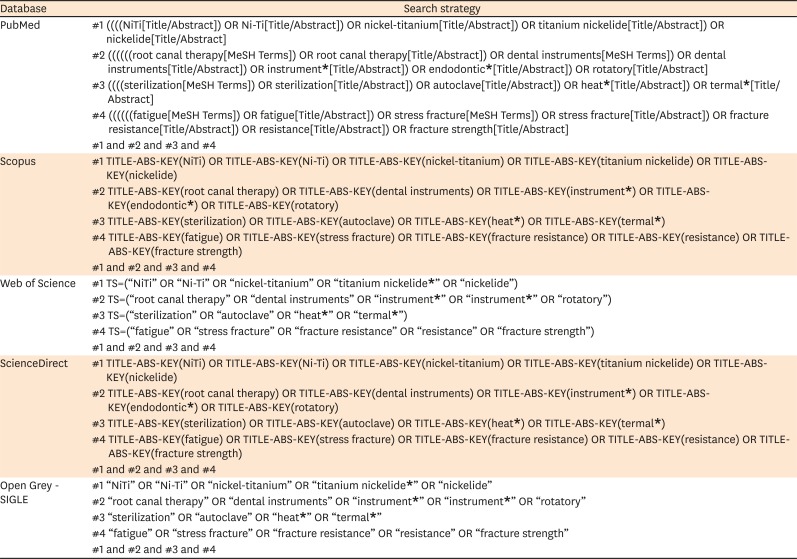
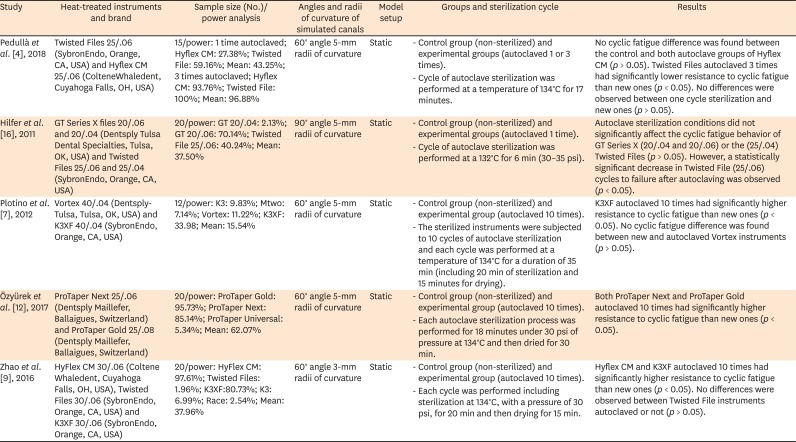
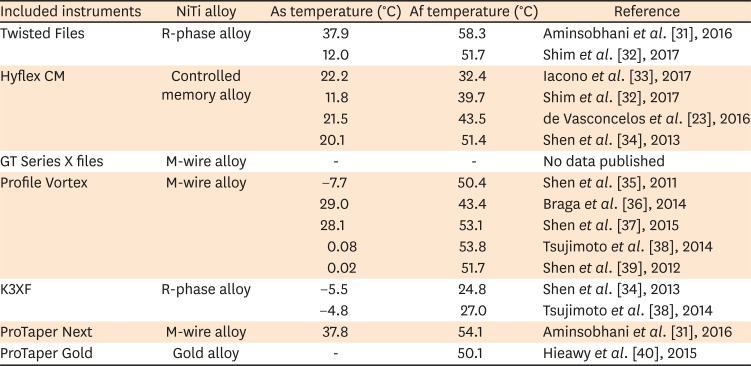




 PDF
PDF Citation
Citation Print
Print



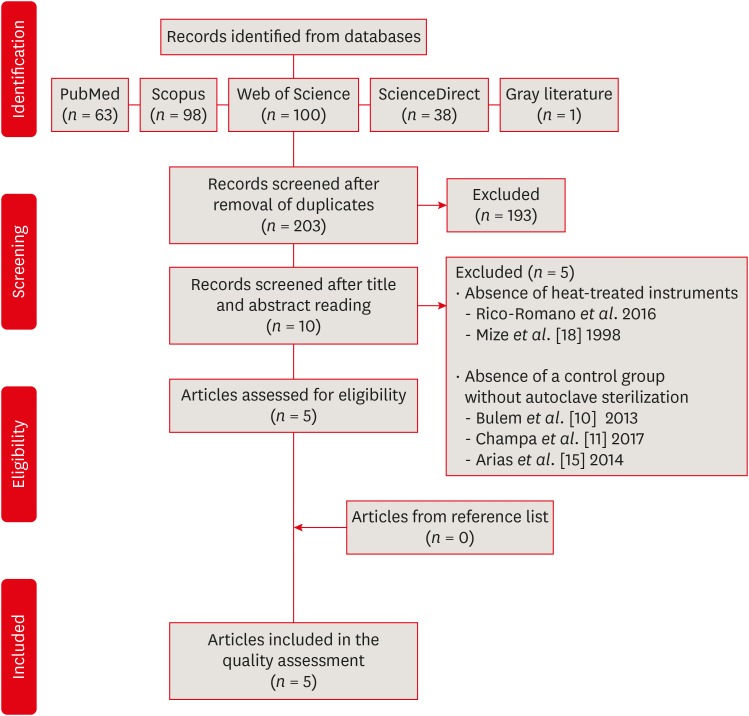
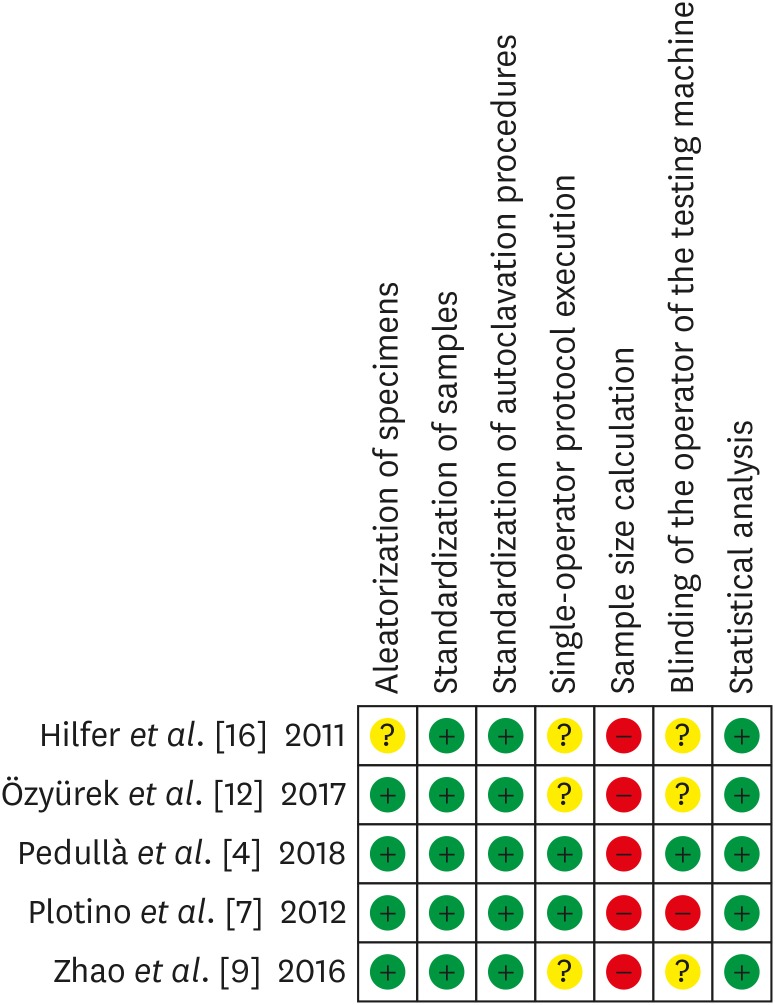
 XML Download
XML Download